Episode 202
What you’ll learn in this episode:
- How Kristen decided to start the next phase of her career at Scotland’s University of Dundee
- Why metalsmithing and jewelry attracts people who like a challenge
- How creating jewelry can be like creating an opera
- What young jewelry artists can learn by entering competitive exhibitions
- Why curiosity can help artists overcome shyness and fear
About Kristin Beeler
Kristin Beeler joined the faculty of Duncan of Jordanstone College of Art and Design at the University of Dundee, Scotland UK in 2023.
From 2002-2023, she was Professor of Art and Coordinator of Jewelry and Metalwork at Long Beach City College in the Los Angeles, California area. She is native to the Blue Ridge Mountains of central Appalachia and is a second generation graduate of historically interracial and craft-centered Berea College receiving a BFA in Crafts and Applied Design with a minor in Philosophy (1989). Her Master of Fine Arts in Jewelry from the University of Arizona (1994) was followed later by post graduate studies at Alchemia Jewellery School in Florence, Italy (2011) and Atelier Rudee, Bangkok, Thailand (2013).
Solo exhibitions include Integumentum 2021 at Baltimore Jewelry Center, Baltimore, Maryland, Archive of Rag and Bone at Mesa Contemporary Arts Museum, Phoenix, Arizona (2016) and Beauty and Other Monsters at Velvet da Vinci Gallery, San Fransisco, California (2007).
Additional Resources:
- Kristin’s Website
- Kristin’s Instagram
- Duncan of Jordanstone College of Art and Design
- The Jewellery and Metal degree programme at Duncan of Jordanstone College of Art and Design Instagram
- Long Beach City College Metalsmithing
- IG:@lbccjewelryandmetalwork
- https://thestrawfactory.com/
- IG:@straw.factory
Photos:
Kristin Beeler in the studio
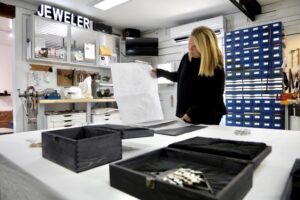
bc1.A and bc1.C
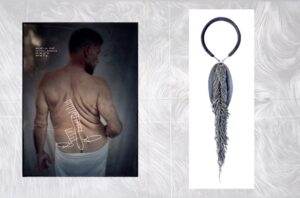
pp1.C2
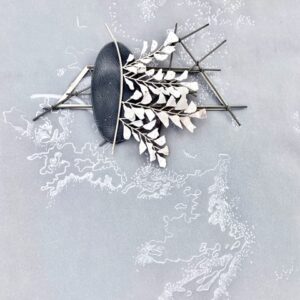
pp1.C1 and worn
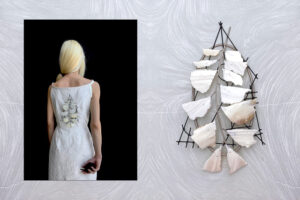
mc1.A and mc1.B
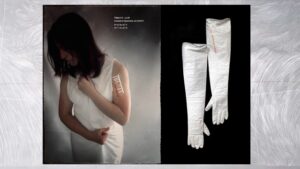
Magdalena’s Pearls
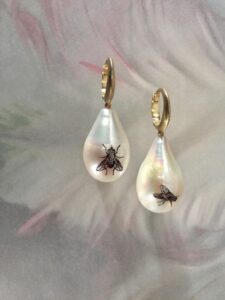
Transcript:
After two decades as a professor at Long Beach City College, artist and jeweler Kristin Beeler is heading back to school herself at Dundee University in Scotland. Although any international move comes with fear, Kristin has relied on a sense of curiosity to keep pushing her work froward. She joined the Jewelry Journey Podcast to talk about why certain artists are drawn to metal; how she tries to create context through her work; and why some of the most important lessons she learned were from submitting her work to competitive exhibitions. Read the episode transcript here.
Sharon: Hello, everyone. Welcome to The Jewelry Journey Podcast. This is the first part of a two-part episode. Please make sure you subscribe so you can hear part two as soon as it’s released later this week. If you look at Kristin Beeler’s jewelry, she looks like she’s a risk taker, but that’s not really true. She has followed a well-worn path, but she also has risk in her work. She received her master’s and then became a professor of art at Long Beach City College. She teaches both metal arts and jewelry. She is the Coordinator of Jewelry and Metalwork for Long Beach City College. She has been at the college for at least seven years, and this is her last term there.
She is not afraid to put herself and her work out there, as evidenced by the many exhibitions and jury situations she has been in. She’s not afraid for others to judge her work, but her biggest risk is upcoming. That is to be a lecturer in the metal arts department at the University of Dundee in Scotland. We’ll hear more about this today. Kristin, I’m glad to have you on the podcast.
Kristin: I’m so glad to be here, Sharon. Thank you.
Sharon: It’s great to have you. First, what are your trepidations about going across the world?
Kristin: It is an adventure for sure. I’ve actually been at Long Beach City College for 21 years. This was my 21st year, so it’s been quite an adventure. It’s been an amazing time to spend with the students and an impressive faculty at the school. It’s been an incredible privilege, and it’s also given me the opportunity to develop a really strong program. Our jewelry entrepreneurship program is only a few years old, but we’ve been able to grow exponentially because of it.
It’s interesting going to Scotland. I’ll be joining the faculty of Duncan of Jordanstone College of Art & Design and the Jewelry and Metal Design Program. It’s an amazing faculty there. They’re one of the top design schools in the U.K. They have an amazing track record, and the faculty has also been working together for a long time. Here, I know where the funders are. I know where the suppliers are. I know where the galleries are. There, it’s all going to be new. I don’t know the funders. I don’t know the suppliers. I don’t know the metrics well enough. All these things are going to be so sparkly and new, so I hope they’re patient with me.
Sharon: Did they come to you, or did you go to them?
Kristin: It’s an interesting story. I have put quite a lot of time into the program at Long Beach City College. As I said, it had grown exponentially, and a lot of that growth happened during the pandemic. There was a lot of extra work that had to be done, and last fall, I took a term off to recover. I was a bit worn out. I was really burned out. So, I took a term off and had some time to think about what I wanted to do with myself after teaching for 20 years. I realized that what I wanted to do was go back to school. I was a bit jealous of my students because they were having such a good time. I’d always wanted to get a Ph.D., so I started talking to programs in the U.K. and EU because there are no practice-based Ph.D.s in our field in the U.S. I was looking for programs that I might be able to start either while I was still teaching and going into semi-retirement or after I retired.
I had had a wonderful conversation with Sandra Wilson at the University of Dundee. They have a wonderful Ph.D. program in jewelry. There are a number of programs they have practice-based Ph.D.s in, and I had a wonderful conversation with her. She was very supportive. I was getting ready to start putting together an application when they posted a full-time lecturer research position, so I thought, “Well, maybe I’ll try that.” I applied for the position and didn’t hear anything back for quite a long time. The university processes have their own pace. I think it was a Friday when I got an email saying, “Can you come and interview next Thursday?” There wasn’t even time to ask if I could do a Zoom interview. I talked to my family, and they said, “Just go.” I left on Tuesday, interviewed on Thursday, and they made their first offer on Friday and I accepted it. It was serendipitous that I happened to be looking at Sandra Wilson’s Instagram. I’d go for days and weeks, months without looking at Instagram, and I happened to look on the right day and see the post about the position opening. Now I’m surrounded by packing boxes.
Sharon: Wow! When you say a practice-based Ph.D. or a practice applied Ph.D., what does that mean and how is it different?
Kristin: Normally we think of Ph.D.s as being text-based. You present a dissertation that is all textual, and you have a verbal defense of the Ph.D. A practice-based Ph.D. can have other formats. Mine will likely have a text component, but also the practice, the work we do in the studio is part of the work for the Ph.D. That is a huge portion of the research. It requires very particular methodologies for approaching that research, but it’s an approach that isn’t very common in the U.S. It’s much more common in the EU, U.K., Australia. I can’t remember if there are any in Asia, but it’s not found that much in the U.S., a practice-based Ph.D.
Sharon: Yeah, you think of a Ph.D., at least the way I know it from the U.S., as “piled higher and deeper.” You’re going to be in a big city. It’s mostly what happens.
Kristin: It’s a wonderful acknowledgement of the actual work and contribution that artists make as opposed to, “Anybody can do that.” When you start to follow a line of inquiry to a very deep level, it allows so much more to unfold. You are able to connect with people who are doing similar work in different fields. I will be talking to people in the life sciences department. They have one of the top life sciences departments in the U.K., so I’ll be able to work with them to do some overlap. It provides some really interesting opportunities for study, which I’m very excited about.
Sharon: How long would it be if you walked in the door and were accepted? How long of a program is it?
Kristin: It’s difficult to say. Three to five years would be normal, I think. As I’m teaching, it’s actually a part of my job to do that research. I’d be similar to someone who’s in the lab doing research for a research lecture. So, I don’t know how long. We’ll see.
Sharon: I had trouble pinning it down because you’re described as professor of metal arts and jewelry arts, applied design and an artist, so I didn’t know. What are you, in a sense?
Kristin: I would hate to have to pick one of those things. We’re very multilayered creatures, aren’t we? I love making tacos, but I’m not someone who only makes tacos. I think that as makers we have our preferences, but just depending on what someone’s interests, inclinations or curiosities are. I primarily work in jewelry because it is a method of approach, a method of inquiry, but what is interesting to me is the relationship to the body, and I particularly enjoy the history of it, its attachments. It has a lot of layering that I find really interesting, but when I get bored or stuck on a problem, I’ll make a garment or I’ll do drawings. It’s not part of my practice to only do one thing. Not everything is a piece of jewelry, even though that’s what I am primarily known for.
Sharon: How does that fit with metal arts?
Kristin: My training is in metal. Understanding both the properties and the way metal works is an interesting challenge. It’s what I teach the most; working with metal and how to master it and develop skill bases. In my own practice, metal is a part that is foundational, but not complete.
Sharon: Do you see a difference in the way the mind works for the students who are more interested in jewelry versus those who are interested in metal? For instance, how do you differentiate? Is there a way the mind works that’s drawn to metal versus a different mind for somebody drawn to jewelry arts or a different area?
Kristin: A teacher that I had a long time ago said, “People who are drawn to metal are people that like a little pushback. They like a little resistance.” Metal has its own logic, and you have to understand and follow that logic. Clay, for example, has a lot of process. It’s very technology driven, but it also can be very intuitive. Painting can be very intuitive. You can go backwards and forwards. With jewelry, there’s a massive skill base that is required technically, so the students who like the idea of working with metal in particular love that challenge. They are turned on by that challenge. They light up when something goes right, and sometimes they even light up when things go wrong because now they have more information.
For students who are attracted specifically to jewelry, often that is a gateway. They’re attracted to the idea of jewelry. Sometimes they’re attracted to the idea of being able to actually make a living in the arts. One of the important things that jewelry has to offer is that you can actually support yourself with your design and art skills. Sometimes, once they get to know the properties of working with metal, they may love it or they may not. Often, they do. Often, they’re really compelled by it. Sometimes they have to find their own way to work with materials that have more flexibility in the processing. You’re right. They are different mindsets in that way.
Sharon: It seems like there would be.
Kristin: You’re absolutely right.
Sharon: You’ve been there for 21 years at the college. Did you pick up your master’s and your Ph.D. while you were teaching, even though some of it’s an applied Ph.D.?
Kristin: I will be starting my Ph.D. in Scotland. That’s part of that plan. I did my Master of Fine Arts at the University of Arizona. That program has closed now. Michael Croft was my primary graduate advisor. Michael is a very gifted educator, fierce when we were in graduate school, but incredibly knowledgeable. He’s not someone whose work you’re going to hear a ton about because he doesn’t aim for the spotlight. He’s a quiet guy, but he made a name for himself in the 70s. He’s a very highly respected jeweler and educator.
His partner is Eleanor Moty, who you may know of. Eleanor Moty was a consistent presence. Even though she was at the University of Wisconsin, Madison, she was a consistent presence in Tucson, where our graduate program was, so she had an influence there. Arizona at the time had four graduate programs in jewelry and metalwork. There was a very strong jewelry and metalwork community in Arizona up until the early 2000s. All of those have either changed or closed in the meantime. So, my inculturation to the jewelry and metalwork community was formed inside, literally, a crucible of the desert of Arizona. There was a very strong community.
In some ways, my undergraduate education was equally or possibly even more formative than my graduate education. I went to Berea College in Berea, Kentucky. It was a small, private, liberal arts college that is one of the very few work colleges in the U.S. That means every student who goes there works for the school and, in exchange, pays little or no tuition. It is one of the top schools in that region, particularly in the south. It’s an amazing place.
There are a couple of things about it. It was founded by abolitionists in 1856 and since that time has had a history of coeducation. It was the first coeducational college in the south. Since that time, that has been its mission: to educate everyone equally. It has also been one of the very few schools that has its own crafts program. The students actually work in college-run craft industries. There is a huge ceramics industry; there’s a huge weaving industry. They closed the jewelry industry right before I got there. The work is made by students, produced by the school and sold by the school, and it’s sold nationally. It has a new designer residence program. Stephen Burks has been the first designer in residence. He is connected to Berea through Design Within Reach and a chair manufacturing company—
Sharon: Herman Miller.
Kristin: Herman Miller, thank you. The program has a tremendous amount of reach, and that program had a huge influence on how I think about craft and community.
Sharon: We will have photos posted on the website. Please head to The JewelryJourney.com to check them out.

